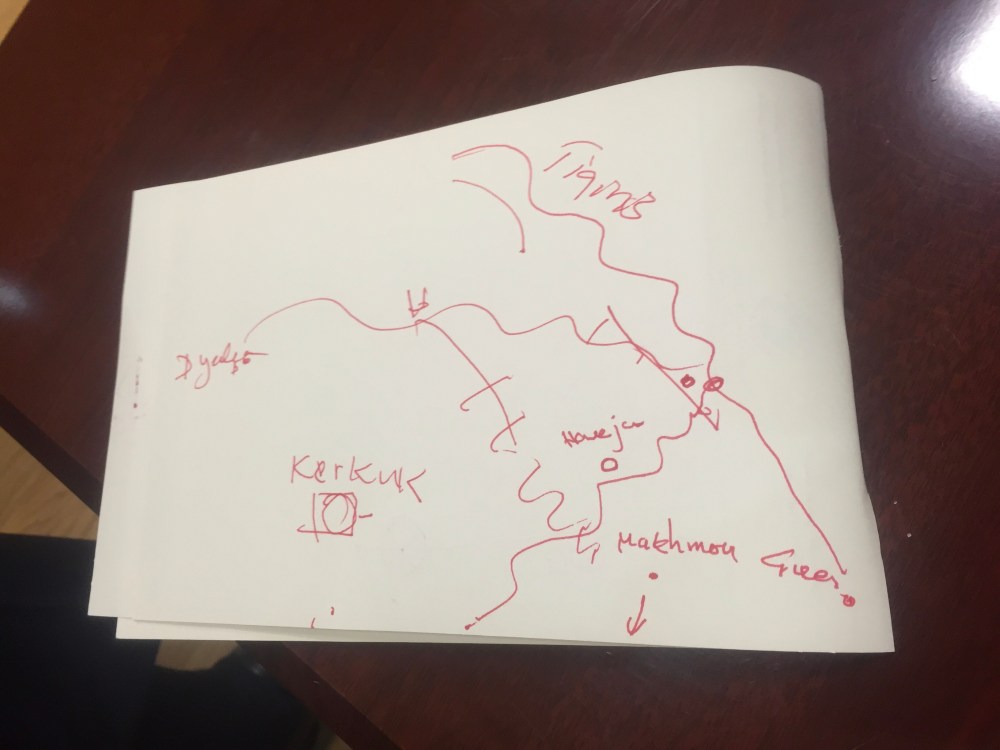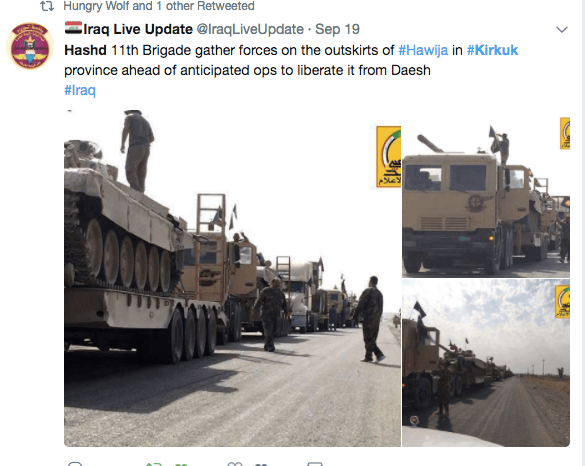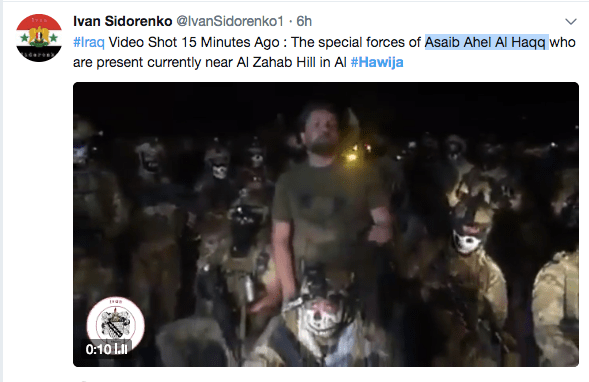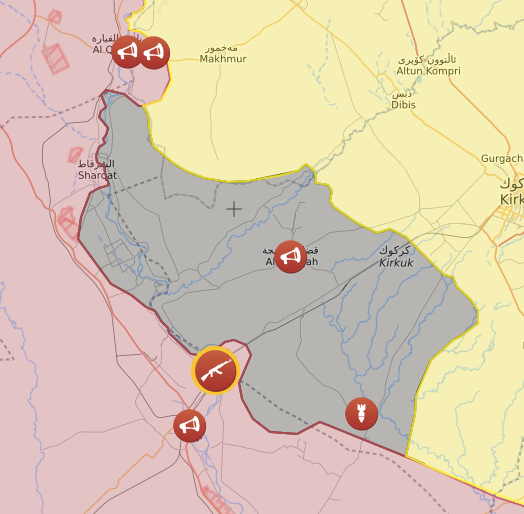By SETH J. FRANTZMAN
Hawija, a town near Kirkuk in northern Iraq, was conquered by ISIS in June 2014. It was home to around 150,000 people. It was a mostly Sunni Arab town with some Shia Turkmen minorities and is separated from Kirkuk city by a line of hills and dry desert landscape. One writer who visited the city just after ISIS took it over recalled in an article at Niqash how it had been abandoned by the Iraqi army. “As we entered Hawija the first thing we saw was the building that was formerly used by the Iraqi army’s 12th Division. A large sign now hangs over the main entrance, reading I’SIS – Secret Operations Room’ in big white letters. According to Iraqi Kurdish officials, ISIS now has an intelligence section so it can better monitor its rivals’ operations.”
Because of the presence of large Sunni Arab tribes (Jubour, etc), the author in 2014 said ISIS was doing “public relations” with the tribes. “Asking around some of the locals later, they say that ISIS is adopting a different, more moderate strategy here. It is fostering good relations with local Sunni Muslim tribes and has told them that they will be in charge in this area.” The 2014 visit concluded, “Most of the people we talked to in Hawija said that they would never allow Prime Minister Nouri al-Maliki’s army to rule over them again.”
Over time ISIS practiced the same cruelty in Hawija that it became known for in Mosul and other places, including mass executions and brutalities. For instance in July 2015 ISIS executed families trying to flee. in August 2016 “The Iraqi Observatory for Human Rights (IOHR) learned from eye witness accounts that 1900 civilians were kidnapped while fleeing Hawija towards the Iraqi Security Forces, who cordoned off the district. Witness accounts detailed the execution of tens of civilians by ISIS, and burning of six others there.”
Hawija was always a center of opposition after the US-led 2003 invasion. It was loyal to Saddam Hussein and the Ba’ath party. It is only 120km from Tikrit, via Biaji. It was also a center of terror operations aimed at Kirkuk during the years before the US surge. A US diplomatic cable in December 30, 2006 notes: “Arab Sunni insurgent and terrorist groups in Kirkuk include Ansar al-Sunna (founded by Sunni Kurds), Jaysh al-Islam and Al-Awda. The pro-Baathist Sunni areas of Hawija in the west and Riyad in the south are especially dangerous.” Although close to Kirkuk its political orientation was not to Erbil or Baghdad. A 2007 cable notes “Another possibility was that political leaders could agree to changes such as moving the Sunni Arab-dominated district of Hawija to Salah ad-Din province.” Many of them opposed Kurdish rule in Kirkuk. ISIS was welcomed in Hawija because supporters of the insurgency had always lived there. A 2017 piece by Charles Glass at Granta told the story of one former Al-Qaeda member who joined ISIS and was later captured by Kurdish forces.
“In 2010, he was selected for a special assignment. ‘We kidnapped a person, a policeman from Hawija.’ They spirited the policeman from Hawija, a Sunni town near Kirkuk, to their camp in nearby Tel Eid. His unit’s emir, or prince, Mazn Mahmoud Abdulqadir, murdered the policeman with a gunshot to the head for ‘training’ purposes. The following year, Ali carried out orders to kidnap three more policemen from Hawija. ‘I executed one, and the emir killed the other two. Pistol shots to the head. The jihadi mentality was a motivation for me. It never bothered me.’”
When ISIS arrived in 2014 many thousands of people fled, eventually totaling almost half a million people or more. Many fled towards Kirkuk. In March 2015 Tikrit was re-taken by the Iraqi army. In October 2015 the Iraqi army liberated Baiji. Meanwhile the Peshmerga after August 2014 and the ISIS threat to Kirkuk had pushed ISIS back to a line of hills overlooking Hawija district. I interviewed Kemal Kirkuki in December 2015 about the Peshmerga frontline and visited the sector. Kirkuki is a former speaker of the KRG parliament, he is a member of politburo of the Kurdistan Democratic Party and head of the region’s public relations office and a commander of the forces in this sector. At the time Kirkuk had become a secure city but threats from ISIS still persisted. In October 2016 when I was covering the Mosul offensive, ISIS attempted a major diversionary attack on Kirkuk, penetrating part of the city after sneaking through the frontline. Kurdish officials told me in 2015 how essential it was to take Hawija to secure areas around Kurdistan.

A map showing Hawija’s strategic security importance (Seth J. Frantzman 2015)
It was clear at the time in 2015-2016 that the Iraqi army and US-led coalition had set their goal as liberating Mosul. An article by Marwan al-Ani at the Washington Institute for Near East Policy wondered why.
“After almost two years, Hawija and its 500,000 majority Arab Sunnis still suffer from ISIS’s occupation. Numerous requests have been made to the governor of Kirkuk to deploy volunteers from Hawija who fled to the Hamrin Mountains to organize and liberate their province. However, the current environment is not receptive to these calls, since the international coalition and the Iraqi government’s plan has remained focused on liberating Anbar, Mosul, and Fallujah. Meanwhile, those planning the fight against ISIS appear to have decided to leave Hawija under ISIS siege for the time being, a reality which has come as a shock to many Sunni Arabs. Around 17,000 families have already fled Hawija to Kirkuk, and many have been forced to leave family members living under ISIS control. ISIS has also targeted Hawija’s infrastructure, gas and oil plants, and power facilities.”
This question still lingers, for a year after the Iraqi Security Forces and Peshmerga launched the Mosul operation, Hawija sat as an isolated ISIS pocket. All the while, ISIS kept abusing the civilians there. Kurdish officials warned that it was a source of extremism. “Hawija has become a center for the Islamic State far before Governor Karim’s statement,” Joel Wing told Paul Iddon for a Rudaw artilce. “Officials in Diyala and Salahaddin, for example, have been complaining for months that ISIS elements have been infiltrating into their provinces from Hawija. That’s because Hawija connects with a string of rural areas in all three provinces, which the insurgents are exploiting.” Kirkuk Governor Najmaldin Karim and police general Sarhad Qadir have indicated the same warnings. Some have even speculated that ISIS members who fled Tal Afar made their way to the Hamrin mountains and Hawija. Since May 2015 some have called Hawija the new headquarters of ISIS in Iraq.
James Snell, writing at The Arab Weekly on September 17th previewed some of the problems involved in the liberation. He quotes Michael Stephens, a research fellow for the Royal United Services Institute, “I expect, as with Tal Afar, that this will all be over quite quickly. The estimation is that there are 2,000 [ISIS] fighters holed up there, but they have been taking casualties at quite a high rate simply from air strikes. I doubt that they can last all that long.”

Peshmerga frontline near Hawija, December 2015 (Seth J. Frantzman)
The referendum changes dynamics
Even though the Kurdish referendum was announced in June of 2017, the Iraqi government and US-led coalition appeared to think it would eventually be postponed as they planned the operation to re-take Hawija. Kurdish Peshmerga also continued planning the operation even as tensions rose about Kirkuk’s inclusion in the referendum. On September 14th the Iraqi central government attempted to remove governor Karim. A car bomb was detonated in Kirkuk. There are major tensions with Turkmen, who make up a sizable portion of the city’s residents.
However the planning to start the operation after September 20th continued right up to when Baghdad announced its launch on September 21st. On September 14th Brett McGurk, Special Presidential Envoy for the Global Coalition To Counter ISIS, gave a press conference in Erbil. He said “I just came from a briefing on a very important meeting that was held today between leaders of the Kurdish Security Forces and the Iraqi Security Forces for upcoming operations in Hawija. And I’m very pleased that that cooperation remains very strong. And that’s something that we want to see continue, obviously. So, even as there are political disagreements ongoing, which I will discuss, it is very important that we remain united and focused on the effort to defeat Daesh and ensure they have a lasting defeat. And this war against Daesh is not over. They are still in Hawija, just south of here. And those operations will be starting very soon. And we have to make sure that we all remain focused on this very serious threat.”
He also noted that Hawija will be a “very, very difficult battle. It’s an essential battle. Daesh remains – they have a headquarters sitting in Hawija, just south of here. We have to make sure that that is rooted out in a smart way. For Kirkuk to be secure, and for Saladin Province to be secure long term we have to get ISIS out of Hawija. And, obviously, those plans are under development, and I won’t get ahead of the process. But that’s a very intense focus of ours, and we want to make sure that nothing that happens here could jeopardize those operations, because we have to get ISIS out of Hawija.”

With the battle commencing there are questions about what role the Peshmerga will play and if it will be an issue in the referendum. In recent days elements of the Hashd al-Shaabi, Shia militias, and Iraqi army gathered near Kirkuk and on six other fronts or axis of attack around the Hawija pocket. The overall area of the battle is around 100 km by 20 km. The presence of Hashd al-Shaabi (PMU) fighting alongside the Iraqi army, as it has in Tal Afar and other places, will make it difficult for the Peshmerga to participate since their relations with the Hashd have been difficult. This is especially true if more extremist elements of the PMU are present.

The Peshmerga control half of the frontline around Hawija, so their role in the operation will be essential. First of all as a defensive blocking force, as they played during the Tal Afar operation. However, as recently as September 7th the disagreements between Baghdad and Erbil were complicating Peshmerga participation. With just days before the referendum, the thought of an offensive starting within 48 hours of voting is disconcerting. However Peshmerga groups, such as the special forces of Task Force Black are ready to repel ISIS fighters who might try a diversion.

Map by ISIS Live map
The coalition’s role
The US coalition spent the last two weeks “shaping the battlement,” which includes numerous airstrikes. There are many issues to focus on, including IDPs that might flee and the need to degrade what weapons ISIS has in Hawija. In recent weeks the airstrikes have increased to several a day as the coalition hopes it can pave the way for the kind of quick success that happened in Tal Afar. Numerous leaflets warning ISIS to surrender have been dropped. A total list of strikes reads as follows (spelling is directly from the CJTF:OIR website, I have left it as is, despite its numerous inconsistencies):
August 31 Near Al Huwayjah, two strikes destroyed five ISIS oil stills and an ISIS-held building.
Sept 3 Near Al Huwayjah, three strikes engaged an ISIS tactical unit and a destroyed a command and control node, an ISIS UAS site, an ammunition cache, a VBIED facility and an ISIS-held building
Sept 4 Near Al Huwayjah, six strikes engaged two ISIS tactical units and destroyed five oil storage tanks, four ISIS-held buildings, a VBIED, an IED facility, a vehicle and a fighting position.
Sept 5 Near Al Huwayjah, three strikes destroyed four ISIS-held buildings and two ISIS headquarters.
Sept 6 Near Al Huwayjah, four strikes engaged an ISIS tactical unit and destroyed five oil stills, two ISIS-held buildings, two ISIS headquarters, and a front-end loader.
Sept 7 Near Al Huwayjah, three strikes engaged an ISIS tactical unit and destroyed two command and control nodes, a vehicle, a VBIED storage facility, and a staging area.
Sept 9 Near Al Huwayjah, three strikes engaged two ISIS tactical units and destroyed two command and control nodes, two weapons caches, a vehicle, an ISIS headquarters and an ISIS-held building.
Sept 10 near Hawijah, Iraq, two strikes engaged an ISIS tactical unit and destroyed two vehicles and an ISIS headquarters.
Sept 11 Near Hawijah, one strike engaged an ISIS tactical unit and destroyed a command and control node and four tunnels.
Sept 12 On Sept. 12, near Hawijah, Iraq, two strikes destroyed four ISIS tunnels, an anti-air artillery system, a mortar system, a weapons cache, an IED facility, a command and control node and a staging area
Sept 13 near Hawijah, Iraq, two strikes engaged an ISIS tactical unit and destroyed four tunnel entrances, two VBIEDs and an ISIS-held building. Near Hawijah, two strikes engaged an ISIS tactical unit and destroyed two weapons caches, two heavy machine guns, two bunkers, an ISIS headquarters, a VBIED facility, and a tunnel system
Sept 14 near Huwijah, Iraq, one strike destroyed 11 VBIEDs and a VBIED facility. Near Hawijah, two strikes engaged an ISIS tactical unit and destroyed three ISIS headquarters, two weapons caches, two VBIEDs, two fighting positions, a command and control node, a mortar system, a heavy machine gun, and a munitions cache
Sept 15 near Hawijah, Iraq, three strikes destroyed two tunnels, a VBIED, and a command and control node; damaged four supply routes; and suppressed a fighting position. Near Hawijah, two strikes destroyed seven VBIEDs, a bunker and a heavy machine gun
Sept 16 Near Hawijah, three strikes engaged an ISIS tactical unit and destroyed four tunnels, three weapons caches, two fighting positions, an excavator, a tactical vehicle, a generator, and a command and control node.
Sept 17 near Huwijah, Iraq, two strikes destroyed a VBIED facility and an ISIS weapons cache. Near Hawijah, three strikes engaged an ISIS tactical unit and destroyed five tunnel entrances, two command and control nodes, a vehicle, a weapons cache, and a generator
Sept 18 Near Huwijah, three strikes engaged an ISIS tactical unit and destroyed four heavy machine guns, three fighting positions, a tactical vehicle, a bunker, a front-end loader, a mortar system, a staging area and an ISIS headquarters
Sept 19 Near Huwijah, five strikes engaged two ISIS tactical units; destroyed three tunnels, two ISIS headquarters, two command and control nodes, a vehicle, a tractor, and a VBIED facility; and damaged two supply routes.
Conclusions
This complex situation now confronts northern Iraq. A major operation to destroy an ISIS stronghold amidst the lead-up to a controversial Kurdish referendum that Baghdad and the US and other coalition members have tried to postpone.

First day of Hawija operations
A look at the map of operations on the first days shows that the PMU is in the center of the line west of Hawija with ISOF and Federal police to the north and other Iraqi units on both sides, including the 9th armored division. There is a unit of PMU near Tuz Khurmatu that may advance towards Rashad in the south of the pocket from the West.
